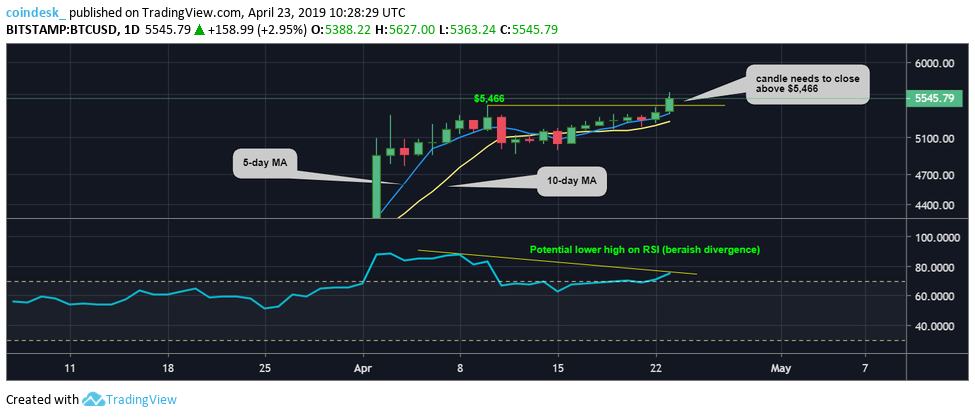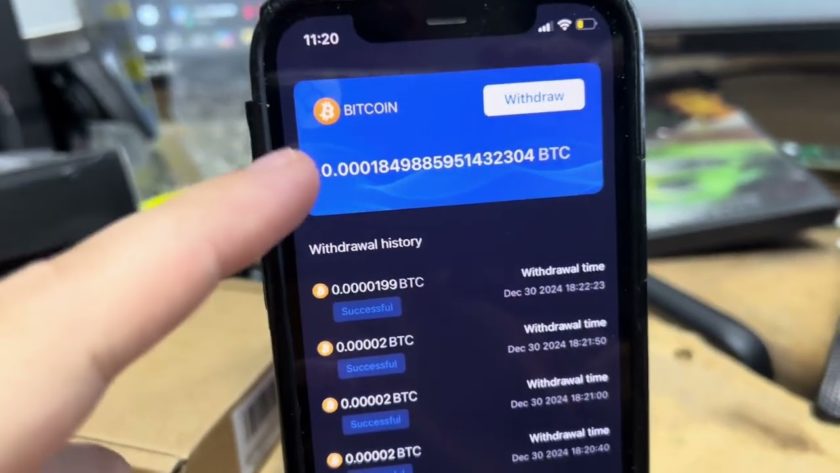View
- Bitcoin’s daily chart is reporting a “golden crossover” – a bull cross of the 50- and 200-day moving averages – for the first time since October 2015. The crossover represents a long-term bearish-to-bullish trend change.
- A convincing close today above $5,466 (April 10 high) would establish another bullish higher high and boost the prospects of a rally to $6,000.
- That rally, however, may be preceded by consolidation or price pullback, as the golden crossover is accompanied by the overbought readings on the relative strength index and a neutral long/short ratio.
- The case for a pullback to $5,000 would strengthen if the price fails to close (UTC) today above $5,466 (April 10 high).
With bitcoin’s (BTC) move to five-month highs Tuesday, a notable bull cross of key moving averages has formed for the first time in nearly four years.
The crypto market leader jumped to $5,627 on Bitstamp earlier today – the highest level since Nov. 18 – having revived the short-term bullish case with a repeated defense of key support at $5,170 last week.
Meanwhile, the 50-day moving average (MA) has crossed the 200-day MA from below, confirming a long-term bullish pattern known as a “golden crossover” in technical parlance. This is the first golden crossover since October 28, 2015. Many analysts consider the indicator an advanced warning of stronger price gains in the long term.
The crossover, however, is based on moving averages, which are backward-looking in nature. For instance, the 50-day MA is based on 1.5-month old data, while the 200-day MA responds to more than six-month-old price action.
Hence, the indicator is more a confirmation of the recent bull run, rather than a signal of further price gains.
That said, the investor community may take heart from the fact that bitcoin’s previous bull market began just two days after the golden crossover in 2015.
Daily charts 2015/2019: Golden crossover confirmed
As can be seen (above left), the 50-day MA last crossed the 200-day MA from below on Oct. 28, 2015, and prices confirmed a long-term bearish-to-bullish trend change with a close above $319 (July 12, 2015 high) two days later.
The follow-through to that positive trend change was strong and BTC went on to reach an all-time high of $20,000 by December 2017.
This time round, the confirmation of the golden crossover has been preceded by the violation of the bearish lower highs and lower lows pattern on April 2.
While there is a reason to be optimistic, the golden crossover lags price, as discussed earlier. Further, it tends to work as a contrary indicator in the short-term if the market is looking overbought, which looks to be the case currently.
RSI and Long/short ratio
The cryptocurrency’s move to five-month highs has pushed the 14-day relative strength index (RSI) above 70 – a sign of overbought conditions. Hence, a price pullback cannot be ruled out in the short term.
Supporting that argument is bitcoin’s long/short ratio, which has shed the bullish bias. The ratio of BTC/USD long to short positions on Bitfinex (right) is currently hovering just below 1.00 – the lowest level since early January – having printed a high of 1.53 on April 8.
The sharp decline indicates the sentiment has turned from bullish to neutral over the last 15 days. Note that a reading well below 1.00 indicates a bearish bias, while an above-1.00 print represents a bullish market.
Daily chart: UTC close is key
A close above the April 10 high of $5,466 would establish another bullish higher high and strengthen the case for a rally toward $6,000.
However, with the golden crossover accompanied by the overbought readings on the RSI, as well as a bullish-to-neutral shift in the long/short ratio, prices may fail to close above $5,466 or the bullish close could be short-lived.
The odds of a fallback to $5,000 would rise if today’s candle ends in the red well below $5,466, validating the lower high (bearish divergence) of the RSI.
Disclosure: The author holds no cryptocurrency assets at the time of writing.
Bitcoin image via Shutterstock; charts by Trading View





